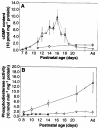Retinal degeneration in mice lacking the gamma subunit of the rod cGMP phosphodiesterase
- PMID: 8638127
- PMCID: PMC2757426
- DOI: 10.1126/science.272.5264.1026
Retinal degeneration in mice lacking the gamma subunit of the rod cGMP phosphodiesterase
Abstract
The retinal cyclic guanosine 3',5'-monophosphate (cGMP) phosphodiesterase (PDE) is a key regulator of phototransduction in the vertebrate visual system. PDE consists of a catalytic core of alpha and beta subunits associated with two inhibitory gamma subunits. A gene-targeting approach was used to disrupt the mouse PDEgamma gene. This mutation resulted in a rapid retinal degeneration resembling human retinitis pigmentosa. In homozygous mutant mice, reduced rather than increased PDE activity was apparent; the PDEalphabeta dimer was formed but lacked hydrolytic activity. Thus, the inhibitory gamma subunit appears to be necessary for integrity of the photoreceptors and expression of PDE activity in vivo.
Figures




References
Publication types
MeSH terms
Substances
Grants and funding
LinkOut - more resources
Full Text Sources
Other Literature Sources
Molecular Biology Databases

